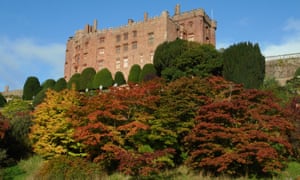A spectacular and prolonged autumn display of colour is predicted for the UK’s parks and gardens thanks to good sunny spells in the spring and September and some nurturing dampness in the summer.
The golds, reds, purples, russets and oranges that provide a burst of joy before the winter months are likely to be particularly vivid this year, the National Trust said.
Happily, this weekend’s storms should not ruin the show because most trees have not reached the point of leaf senescence, or degradation, where the high winds might have stripped them bare.
One of the most spectacular displays may be at Stourhead in Wiltshire, where exotic species such as tulip and katsura trees stand alongside natives such as oak, beech and birch.
Toby Yorke, a senior gardener at Stourhead, said: “In autumn the tulip tree’s leaves gradually become a vivid yellow, ending up almost golden near the end of October. Meanwhile, the katsura trees are dropping their heart-shaped leaves and releasing a lovely sweet scent of candy floss.”
Tom Hill, who looks after sites at Winkworth Arboretum in Surrey and Petworth Park in West Sussex, said: “We’re starting to see some of the maple trees start to turn – from greens to reds and oranges. The whole hillside at Winkworth lights up in a kaleidoscope of colour. Acers and maples are the stars while liquidambar [American sweetgum] leaves turn crimson, orange and purple.”
Winkworth Arboretum
(@WinkworthNT)There’s some beautiful splashes of autumn colour starting to appear, as we gear up for the very best few weeks of the season ??
We’re accepting pre-booked tickets only at this time, details on our website >> https://t.co/G8AKiJ5iFz
National Trust images/Hugh Mothersole pic.twitter.com/sjHcumMKRw
At Mount Stewart in Northern Ireland, the assistant head gardener, Oliver Johnson, said he loved the light at this time of year. “It comes in low, gentle bronze rays picking out the nooks of the wrinkled bark of oaks and the hammered metal texture of the Scots pines and is radiated back to the world by the startling orange bark of the Luma apiculata, the Chilean myrtles.”
Simon Toomer, a plant specialist at the trust, said autumn in the northern hemisphere was one of the natural world’s great spectacles. “It starts in the far northern deciduous forests and progresses southwards to the warm temperate regions over about a 10-week period,” he said.
“The primary trigger for trees to begin the process of shutting down for the winter and shedding leaves is day length, but weather conditions through the summer and early autumn affect the rate of leaf loss and intensity of colour.”

Toomer said it was important for people to get out into nature, especially at this difficult time.
“With the evenings already drawing in and with the potential of further localised lockdowns due to coronavirus, it’s more important than ever that we take the time to notice nature and to drink in the colourful landscapes that we can see at this time of year,” he said.
“Together with the particular dusky, heavy scent of autumn and the sounds of crisp leaves crunching under foot, will all serve to help our wellbeing through the next few colder, darker months.”